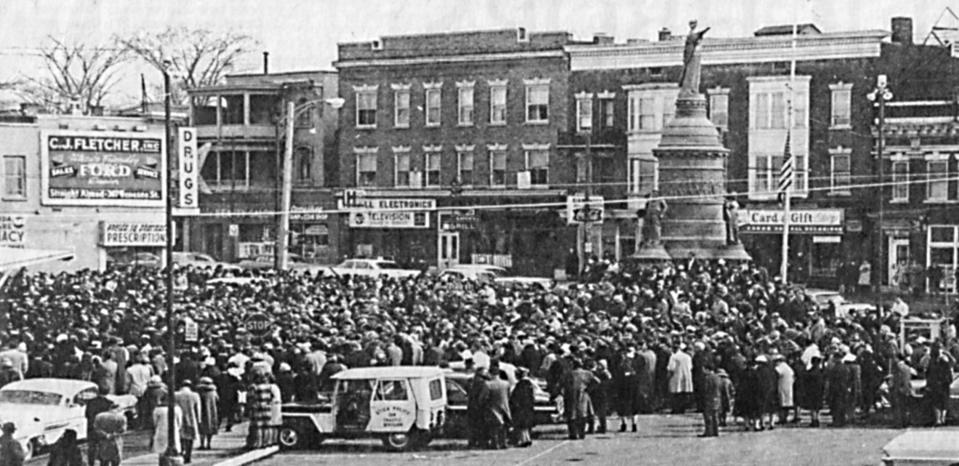Western NY university's story begins with Utica businessman: Mohawk Valley history
1854, 169 years ago
A charitable Utican
Nicholas Devereux, wealthy Utica businessman, is in Rome where he meets Pope Pius IX and agrees to head a fundraising drive to build the pope's favorite project — a North American College in Rome to prepare seminarians to become priests in the United States and elsewhere.
Devereux spends most of his time, however, with friars from the religious order founded by St. Francis of Assisi in the 13th century. Devereux, a devout Roman Catholic, asks for the meeting with the Franciscans to convince them to help fulfill a dream he — and Bishop John Timon of Buffalo — have had for many years. Their conversion probably went something like this:
DEVEREUX: "Fathers, your missionaries carry the Gospel to all parts of the world. I invite you to western New York to establish there a mission and, perhaps, a university and seminary."
FRIARS: "That is a tempting offer, Mr. Devereux, but we have no land there and no money to purchase any."
DEVEREUX: "Years ago, I and others purchased from the Holland Land Company tens of thousands of acres in Allegany and Cattaraugus (and today what is Wyoming) counties in southwestern New York. I will give you 200 acres and the money needed to build your mission there."
The Franciscans accepted the offer, arrived in New York and in 1858 opened a school. They named it after one of the order's early minister-generals, St. Bonaventura. Devereux did not live to see the opening of St. Bonaventure University for he died on Dec. 29, 1855. But his names lives on today on the college campus for the main dormitory there — Devereux Hall — is named for him, as is Devereux Street in downtown Utica.

1923, 100 years ago
It's a first
Utica, for the first time in its history, is among the 73 cities in the country with a population of 100,000 or more. It ranks 73rd with 103,457. Other cities added to the list since 1920 are Erie, Pennsylvania; Flint, Michigan, and Tulsa, Oklahoma.
1948, 75 years ago
Munson elected
Cary Munson is elected president of the Oriskany Falls Volunteer Fire Department.
More: Flooding brings literary great to Utica for the night: This week in Mohawk Valley history
More: With no first lady, president finds 'official hostess' near Utica: This week in history
More: Blizzard of 1888 strands Utica's Roscoe Conkling: Mohawk Valley history
1973, 50 years ago
UNIVAC contract
The Sperry UNIVAC Division's plant in Utica receives a $25 million contract from the Army for an automated communications processing system. It includes 30 UNIVAC 9400 computer systems and 30 terminals. A company spokesman says people will be hired soon, but "it's too early to say how many." The Utica plant — on Turner Street on the city's east end — now employs about 2,000.
Oriskany Falls Central High's basketball team has won 21 in a row and the Section III Class E and Semongca League championships. The Robert Friers-coached team includes Randall Burleigh, William Spooner, Peter Buckoski, Steven King, Douglas Wright, John Condon, Neil Jeffers, David Petrie, Daniel Diana and Bryan Hill.
1998, 25 years ago
Vernon Downs
The 46th opening of Vernon Downs attracts 2,163 racing fans. It is the largest opening-night crowd in five years. Money wagered on live races total $207,012, up from last year's $161,129.
"This is better than we expected," says track president Justice Cheney.
The All-Mohawk Valley Boys Basketball squad has on its first team: Andy Ferris, Waterville High; Walt Savage, Proctor High; Jon Snyder, West Canada Valley; Lance Durham, Owen D. Young, and Brett Barnard, Frankfort-Schuyler. Second team: Ira Montgomery, Clinton High; Nick Rhyde, Hamilton High; Jeremy Wisheart, Holland Patent; Noah Hammond, New Hartford, and Evan Howard, Canastota. Honorable mention: Scott Bush, Madison; Mike Plonisch, Notre Dame; Frank Cassella, Frankfort-Schuyler; Todd Marshall, Stockbridge Valley, and Jason Maurer, Adirondack.
The Utica Maennerchor honors three high school students who excel in the studies of the German language: Willie Krause, New Hartford; Hannah Schlotterer, Rome Free Academy, and Amanda Gould, Dolgeville.
2013, 10 years ago
Centennial celebration
The Holland Patent Chapter of the National Society of the Daughters of the American Revolution, celebrates its 100th anniversary. Outgoing chapter regent Bunny Doolittle says the chapter was founded on March 5, 1913 by a group of women living in the Holland Patent area.
Trivia quiz
There have been 50 "first ladies" in U.S. history. How many presidents' wives are living today? (Answer will appear here next week.)
Answer to last week's question: The 21-gun salute used to honor presidents of the United States and some foreign leaders commemorate the year 1776 when the United States was born. The saluters fire in a one-seven-seven-six sequence of volleys that add up to 21.
This Week in History is researched and written by Frank Tomaino. E-mail him at ftomaino221@gmail.com.
This article originally appeared on Observer-Dispatch: Utica businessman helps start university in NY: Mohawk Valley history

